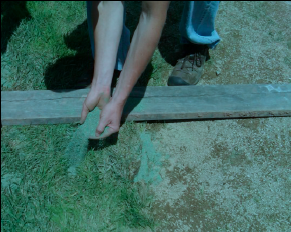Preparing Your Field for Spring
Written By: Ken Mrock, Head Groundskeeper of the Chicago Bears
Many parts of the country have enjoyed an early spring this year. From a turf management standpoint, that makes it even more important that you get out on the field as soon as possible – because the players won’t be far behind!
 Following are some first steps when uncovering your turf for the spring season, followed by some of my best maintenance practices to ensure that your turf remains in good condition throughout the year ahead.
Following are some first steps when uncovering your turf for the spring season, followed by some of my best maintenance practices to ensure that your turf remains in good condition throughout the year ahead.
- As soon as you are able, walk the entire field and evaluate the conditions.
- Note any winter damage, vandalism, or areas requiring special attention.
- Refer back to any lists made in the fall so you can track any outstanding tasks not previously accomplished or items that were on your “to do before next season” list.
- Put together an action plan and get to work as early as weather permits.
- If you need assistance with soil testing, developing a maintenance plan or selecting appropriate products, consult your local field supply distributor.
Tip #1: Damage Control
 Fill in any low areas and repair any vandalism or damage done during the winter months. Allowing a team to take the field before safety issues are addressed could lead to serious injury and a rough start to the season.
Fill in any low areas and repair any vandalism or damage done during the winter months. Allowing a team to take the field before safety issues are addressed could lead to serious injury and a rough start to the season.
Tip #2: Soils Analysis
 I always harp on the importance of performing a soil analysis. Trying to address your fields’ needs without one is like performing surgery without an x-ray. It is the true roadmap to success. Have one done every couple of years. Remember to take samples prior to any fertilizer or lime applications.
I always harp on the importance of performing a soil analysis. Trying to address your fields’ needs without one is like performing surgery without an x-ray. It is the true roadmap to success. Have one done every couple of years. Remember to take samples prior to any fertilizer or lime applications.
Tip #3: Aerate and Topdress
Aeration is the lifeblood of healthy turf. It helps relieve compaction, improve drainage, reduces thatch and organic buildup, and most importantly helps promote the exchange of gases and delivers oxygen into the rootzone. In anticipation of spring rains, topdress with Field and Fairway to provide moisture control and improved footing, preventing slippery muddy areas from forming. Concentrate material in heavy wear areas to protect the crowns of the plant, especially if rain is predicted during a game.
Tip #4: Fertility
 Timing is everything with spring fertilizing. Don’t make the application too early. Wait until the grass plant flushes on its own, and then replenish its food. Premature fertilizing pushes the plant too early, using up its carbohydrate reserves and leaving the plant without necessary nutrients.
Timing is everything with spring fertilizing. Don’t make the application too early. Wait until the grass plant flushes on its own, and then replenish its food. Premature fertilizing pushes the plant too early, using up its carbohydrate reserves and leaving the plant without necessary nutrients.
Tip #5: Crabgrass Control
The first question to be answered is whether the field is going to be over-seeded. If not, then preemergent herbicides like Team Pro, Barricade, Dimension or Pre-M may be applied. If seeding is necessary, then the preemergent Tupersan (Siduron) may be applied in conjunction with seeding. Note that Tupersan will need to be applied several times.
Tip #6: Mowing
 Sharpen mower blades or reels to avoid ripping or chewing the grass blade. Dull blades can quickly result in stress to the turf. Maintain a mowing height that is consistent with the sport being played. Remember the 1/3 rule: never remove more than 1/3 of leaf blade at any one mowing. If the turf has become too high, then it is necessary to raise the mower blade and gradually bring the turf down to the desired height. If turf blankets were used, mow several times before putting the field into play.
Sharpen mower blades or reels to avoid ripping or chewing the grass blade. Dull blades can quickly result in stress to the turf. Maintain a mowing height that is consistent with the sport being played. Remember the 1/3 rule: never remove more than 1/3 of leaf blade at any one mowing. If the turf has become too high, then it is necessary to raise the mower blade and gradually bring the turf down to the desired height. If turf blankets were used, mow several times before putting the field into play.
Tip #7: Irrigation System
Check all irrigation heads to ensure that they are level, and make sure they are also recessed the proper depth. Test the lines and address any issues immediately so that you can ensure even moisture across the field.
Tip #8: Turf Needs Rest
 Consider this when planning a field use schedule. Just like a starting pitcher needs rest between starts, so does your turf. Encourage coaches to rotate practice drill locations. Avoid having players line up down the foul line when warming up. And if you have multiple teams sharing one field, encourage them to allow at least one day of rest each week if possible!
Consider this when planning a field use schedule. Just like a starting pitcher needs rest between starts, so does your turf. Encourage coaches to rotate practice drill locations. Avoid having players line up down the foul line when warming up. And if you have multiple teams sharing one field, encourage them to allow at least one day of rest each week if possible!
It’s not always easy to control the amount of use your turf will get, nor can you influence the weather conditions that test your field during a season. But taking proper steps in the spring to prepare for the year ahead will give you a head start on everything that may come your way.